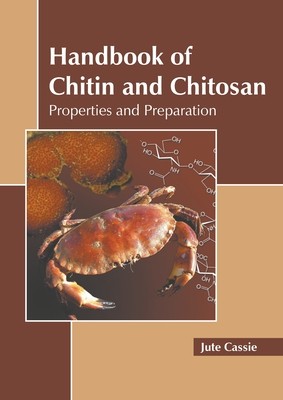
- We will send in 10–14 business days.
- Publisher: States Academic Press
- ISBN-10: 1639892532
- ISBN-13: 9781639892532
- Format: 21.6 x 27.9 x 1.4 cm, hardcover
- Language: English
- SAVE -10% with code: EXTRA
Handbook of Chitin and Chitosan: Properties and Preparation (e-book) (used book) | bookbook.eu
Reviews
Description
Chitin is a polysaccharide which is a long chain polymer of N-acetylglucosamine. It is found in the cell walls of fungi and exoskeletons of arthropods such as insects, crustaceans, cephalopod beaks and scales of fish. It has a structure comparable to cellulose. Chitosan is formed by the treatment of chitin cells of crustaceans with an alkaline substance like sodium hydroxide. It is a linear polysaccharide which consists of randomly distributed β-(1→4) linked D-glucosamine and N-acetyl-D-glucosamine. Chitin is used to create edible films in food industry. It is also used as an additive to stabilize and thicken foods and food emulsions. Chitosan is used as a pesticide to fight plant fungal infections. It also finds applications in beverage industry as fining agent and as an antibacterial agent in bandages to help reduce bleeding. This book outlines the properties and preparation of chitin and chitosan in detail. The topics included herein on chitin and chitosan are of utmost significance and bound to provide incredible insights to readers. This book is a vital tool for all researching or studying chitin and chitosan as it gives incredible insights into emerging trends and concepts.
EXTRA 10 % discount with code: EXTRA
The promotion ends in 18d.11:20:56
The discount code is valid when purchasing from 10 €. Discounts do not stack.
- Publisher: States Academic Press
- ISBN-10: 1639892532
- ISBN-13: 9781639892532
- Format: 21.6 x 27.9 x 1.4 cm, hardcover
- Language: English English
Chitin is a polysaccharide which is a long chain polymer of N-acetylglucosamine. It is found in the cell walls of fungi and exoskeletons of arthropods such as insects, crustaceans, cephalopod beaks and scales of fish. It has a structure comparable to cellulose. Chitosan is formed by the treatment of chitin cells of crustaceans with an alkaline substance like sodium hydroxide. It is a linear polysaccharide which consists of randomly distributed β-(1→4) linked D-glucosamine and N-acetyl-D-glucosamine. Chitin is used to create edible films in food industry. It is also used as an additive to stabilize and thicken foods and food emulsions. Chitosan is used as a pesticide to fight plant fungal infections. It also finds applications in beverage industry as fining agent and as an antibacterial agent in bandages to help reduce bleeding. This book outlines the properties and preparation of chitin and chitosan in detail. The topics included herein on chitin and chitosan are of utmost significance and bound to provide incredible insights to readers. This book is a vital tool for all researching or studying chitin and chitosan as it gives incredible insights into emerging trends and concepts.


Reviews